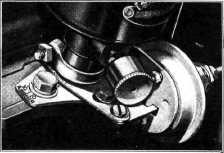1942 - 1947 CHEVROLET SHOP MANUAL
Section 6 - Engine
|
|
|||
|
6-32 |
|||
|
|
|||
|
Ignition Distributor
The
ignition distributor is designed to operate with a polarity reversing switch which
reverses the polarity or
direction of current flow, through the distributor points thereby greatly lengthening
their life. The breaker plate
is completely insulated from the distributor body by a strip of
insulating material extending
from one distributor cap clamp location to the other. The screws attaching these
clamps to the distributor body
are screwed into nuts made of insulation material located inside the
breaker plate lugs. One
primary terminal is located in the distributor body and insulated the same as on
former models; the other
primary terminal is insulated from the distributor body and screwed into a
lug on the breaker plate. The
breaker cams have a steep
angle, insuring that the breaker points remain closed for the greatest number of degrees
of cam rotation, thereby
permitting current to flow through the primary winding of the coil a greater
length of time. This results
in greater magnetic saturation of the coil which in turn increases the
coil output of secondary
current. Fig. 67 shows the ignition distributor. |
the trouble corrected. See
instructions for this operation in
Section 12 of this Manual.
Examine
the distributor points. Dirty points should be cleaned, and pitted or worn points
should be replaced. Check the
points for alignment, and
align them if necessary.
Hand-crank
the engine until the distributor point
cam follower rests on the peak of the cam. Adjust the point gap to .018", using a
feeler gauge. This operation
must be performed very accurately because it affects the point dwell or
length of time the points
remain closed in operation and, in turn, ignition coil
performance.
Hand-crank the engine until the
cam follower is located between the cams. Hook the end of a distributor point scale over the movable point
and pull steadily on the spring
scale until the points just start to open. At this point the
reading on the scale should be
between 17 and 21 ounces.
Check to
see that the vacuum spark control operates freely by turning the distributor
body counterclockwise and see
that the spring returns it to
the retarded position. Any stiffness in the operation of the vacuum spark control will
affect the ignition timing.
Ignition Timing
Set the
octane selector at "O" on the scale, Fig. 68, and attach a Neon Timing Light to No. 1
spark plug. Start the engine
and run it at idling speed. Loosen distributor clamp and rotate the
distributor body clockwise and
counterclockwise until the steel ball in the flywheel lines up with
the pointer on the flywheel housing. Tighten the distributor clamp screw. |
||
 |
|||
 |
|||
|
Fig. 67—Ignition Distributor
Remove the
spark plug wires from the distributor cap and examine the terminals for
corrosion. The wires should be
checked for damaged insulation and oil soaked
condition.
Remove
the distributor cap. Check the cap and distributor rotor for cracks or burned
contacts.
Check the
distributor automatic advance mechanism by turning the distributor cam in a
clockwise direction as
far as possible, then release the cam and see if the springs return it to its
retarded position. If the cam
does not return readily, the distributor must be disassembled and the
cause of |
|||
|
Fig. 68—Octane Selector
Reassemble
the distributor cap and spark plug wires. Make sure that all terminals of the
primary wire at the ignition
coil, reversing switch and distributor are clean and
tight. |
|||
|
|
|||